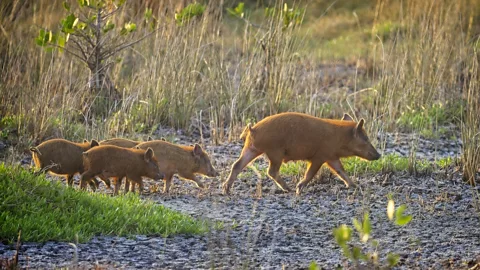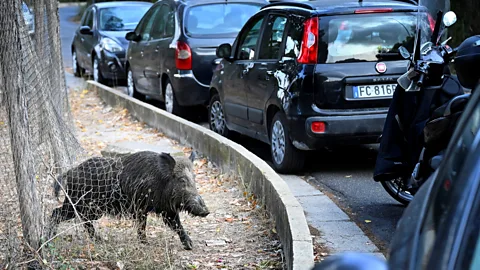Boisterous, destructive and divisive: North America's wild boar population is on the rise
 Getty Images
Getty ImagesHybridised feral pigs are considered an invasive pest in North America. But Europe's rewilding movement is rethinking the roles that this spirited animal can play.
The pop superstar Shakira experiences many forms of attention; some wanted, some not, and some in the form of wild animals. In autumn 2020, while walking with her son in a Barcelona park, she faced the latter: an assault by a pair of bag-snatching wild boars. "They've destroyed everything," she later said of her boar-torn purse.
The singer's assailants are not uncommon in urban Europe. Once hunted at scale (and to extinction in the UK), the naturally reclusive wild boar is on the rise again across the continent. And, from the beaches of Marbella to the streets of Rome, they are also becoming increasingly bold; nosing their way into both handbags and headlines by biting backsides, accosting shoppers, and prompting curfews to protect residents. In Berlin recently, authorities believe one of the city's 3,000-5,000 "wildschwein" was even mistaken for a lion.
In North America too, concern over feral swine or hogs, as they are known in the US, is growing. First imported by European explorers more than five centuries ago, domestic escapees soon formed the continent’s first invasive populations. In the 1900s, these were ed by wild boar shipped over for hunting. Today, at least 35 US states have highly fecund wild drifts. Numbering an estimated six million and rising, these boar-domestic hybrids are thought to cause an annual $2.5bn (£2.1bn) in damage to US crops, especially peanuts and corn, as well as affecting forests and livestock.
But as wild swine have been reclaiming and expanding their range, so has a new outlook on humanity's relationship to nature been gaining ground. Known as rewilding, the European-born movement aims to return landscapes to a wilder state. One prominent means of achieving this is through "trophic" rewilding, in which missing species of large animals and plants are reintroduced or replicated. In doing so, natural processes that can encourage biodiversity are restored and ecological richness unleashed, proponents argue.
So where do wild pigs fit in? Are they welcome megafauna or menace? And in today's crowded landscapes – where some species are missing and others are invasive – can we hope to achieve a balance that works for wildlife and humanity alike?
 Getty Images
Getty ImagesFor Ryan Brook, professor at the University of Saskatchewan's department of animal and poultry science, "wild pigs are the worst invasive large mammal on the planet from a Canadian perspective". He and others cite the "tremendous" damage their rooting, wallowing and trampling has done to agricultural crops; as well as the threats they pose to livestock, endangered wildlife, disease transmission and water quality.
Brook's team have thus mapped the hogs' advance across Canada, and even identified what they call a "super pig" – a fast-breeding hybrid that is well-adjusted to cold climates. A group started by researchers, called "Squeal on Pigs", is now on the lookout for their spread across the border.
Inside the US, there is already a national programme working to see existing wild pig numbers controlled or, "where feasible", eradicated. Considering their conservation threats and the economic damage their spread has led to, this approach receives widespread .
"Economically and ecologically, the hog invasion has had an overwhelmingly negative effect," says Marc Hensel, a coastal ecologist at the University of Florida's Nature Coast Biological Station.
And yet, alongside recognition of the need to control numbers and prevent habitat destruction, there is also a smaller strand of conservation science, which Hensel is helping feed into, that is starting to think more holistically about how boar behaviour reshapes the ecosystems of natural areas.
